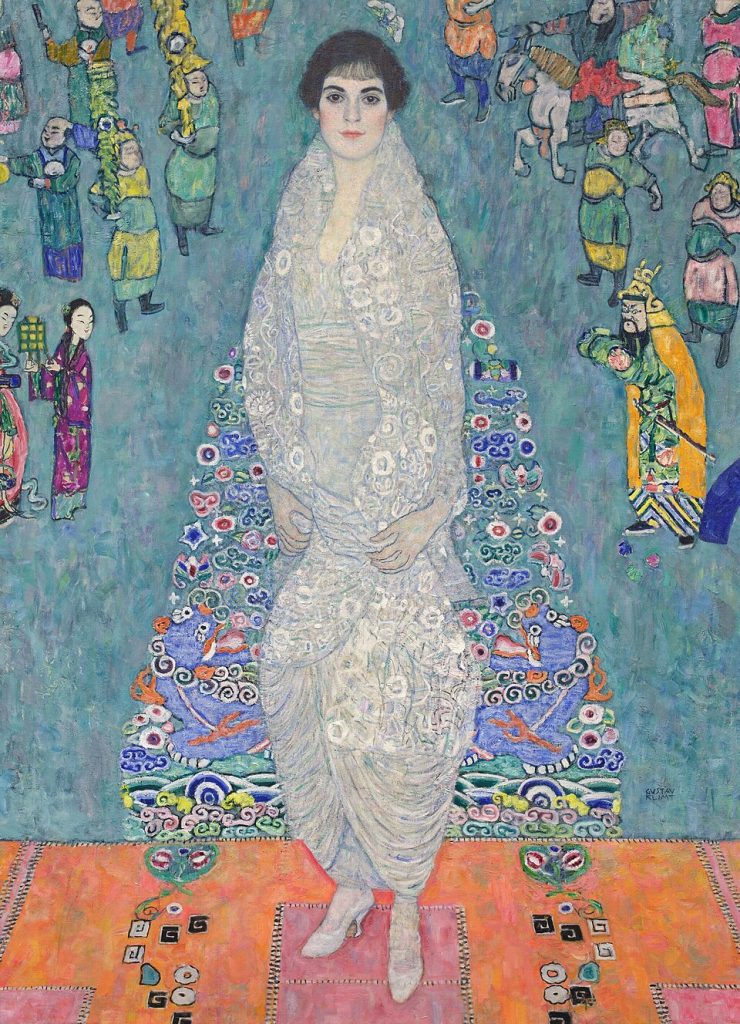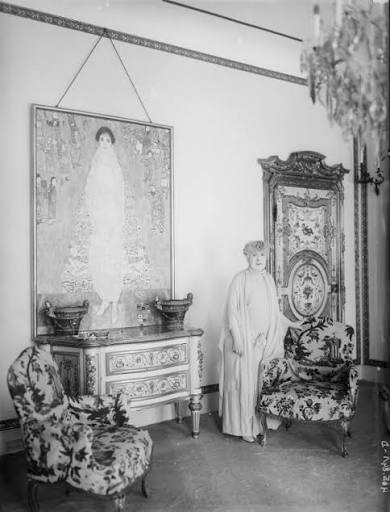Experience Travel Insights
August, Serena, Elisabeth Lederer and Gustav Klimt: From Vienna’s Golden Age to Wartime Ashes
Could claiming Klimt as your father save you from the Nazis? This untold Jewish story reveals extraordinary resilience amid devastating loss. Discover the Lederer family’s profound patronage of Klimt, their audacious survival tactics, and the heartbreaking cultural void left by Nazi plunder. It’s a powerful testament to their legacy and the ongoing fight to reclaim what was stolen.
by Long Lin-Maurer • November 20, 2025

The Lederer Family and Gustav Klimt: A Saga of Art, Patronage, and Loss
In the glittering, intellectually fervent world of fin-de-siècle Vienna, a city of decadent dreams and radical new ideas, few names shone brighter in the constellation of cultural patronage than the Lederer family. Their story is more than one of wealth and exquisite taste; it is an intimate and ultimately tragic saga. The relationship between the Lederer Family and Gustav Klimt is a defining narrative of creative flourishing, profound loss, and improbable survival that continues to echo through the grand boulevards and hushed museum halls of the Austrian capital.
Come and experience travel!
Personally designed, seamlessly delivered – your journey, our expertise!
We are a boutique travel agency and consultancy specializing in Hub & Spoke Tours across Central Europe, the Benelux and the Dolomites.
At the heart of this story are August and Serena Lederer, a couple who embodied the dynamism of Vienna’s assimilated Jewish bourgeoisie. They were some of Klimt’s most prominent patrons and the second wealthiest family in Vienna, behind only the Rothschilds at the beginning of 20th century. August was a formidable industrialist, his fortune built on spirits manufacturing. Serena, a woman of renowned beauty and style, was the true driving force behind their artistic endeavors and art patronage, a “Grande Dame” so chic that the architect Josef Hoffmann once called her the “best-dressed woman in Vienna.” Together, they cultivated a deep, personal friendship with Gustav Klimt, becoming not just his patrons, but his champions.
Their Vienna apartment on Bartensteingasse 8, near Klimt’s studio, was more than a home; it was a sanctuary for modern art. Here, the Lederers assembled what would become the largest and most significant private collection of Klimt’s work in the world. The Lederer family’s Klimt collection was a breathtaking survey of his genius, from early portraits to his most controversial and groundbreaking works.
Klimt and the Lederers: A Patronage Forged in Friendship
Gustav Klimt’s relationship with the Lederers began in earnest around the turn of the century with the commission for Serena’s portrait in 1899. The resulting painting, now housed in New York’s Metropolitan Museum of Art, is a symphony in white. Klimt presents Serena as a graceful, almost ethereal figure, her form enveloped in a soft, flowing gown that blends into a misty background. A critic at the time rapturously described her as “an upright flower, long-stemmed … like a black tulip.” This portrait marked the beginning of a nearly 20-year alliance built on mutual admiration and intellectual kinship.
Klimt became a regular fixture in the Lederer household, a frequent guest for meals and a participant in their lively social salons. His bond with the family was so profound that it extended across generations. He painted Serena’s mother, Charlotte Pulitzer, and, most famously, the Lederers’ daughter, Elisabeth. He also provided drawing lessons to the artistically inclined Serena and her daughter.
The support from Klimt’s patrons, the Lederer family, was not merely financial; it was courageous. When Klimt’s monumental “Faculty Paintings” (Philosophy, Medicine, and Jurisprudence), commissioned for the Great Hall of Vienna University, were rejected and decried as pornographic and perverse, the Lederers stepped in. August Lederer purchased Philosophy in 1905, and later acquired Jurisprudence, providing a safe harbor for works deemed too radical for the establishment.


Elisabeth Lederer’s Portrait: A Klimt Masterpiece and a Shield
The deep Lederer-Klimt connection is perhaps best exemplified between 1914 and 1916, when Klimt devoted himself to the portrait of the Lederers’ daughter, Elisabeth Lederer (born Jan 20, 1894). The full-length painting depicts a confident young woman, her gaze direct, enveloped in a fantastical cloak set against a backdrop of vibrant, East Asian-inspired figures. August and Serena Lederer commissioned the portrait for their young beautiful daughter, yet adult but still living at home in 1914. It took Klimt whole three years to complete. Inbetween Klimt and Serena Lederer often argued over the painting, with Klimt never quite satisfied with it. Allegedly, Serena Lederer, convinced the portrait was complete, took the painting from Klimt’s studio herself. Ultimately, the Lederers received the painting in 1916 despite Klimt’s desire to keep revising it. The painting only left the Lederer collection once in 1917, to display at the Austrian Art Exhibition in Stockholm.
Come and experience travel!
We design bespoke travel experiences with a perfect balance of cultural depth, efficiency and comfort.
Specializing in seamless hub-and-spoke journeys, we create well-paced, immersive itineraries tailored to your interests.
The work is a testament to the family’s sophistication and a high point of Klimt’s late portraiture.
This painting would later become more than just a masterpiece; for Elisabeth, it became a shield. After the Anschluss in 1938, when Nazi Germany annexed Austria, the Lederer family, like all Jewish citizens, faced persecution and methodical seizure of their property. Their vast business empire was “Aryanized,” and their unparalleled art collection was systematically looted in a devastating campaign of Nazi art theft.
While her brothers and mother fled, Elisabeth remained in Vienna. In a desperate and audacious act of survival, she asserted that she was not the legitimate daughter of August Lederer, but the illegitimate child of Gustav Klimt, who was not Jewish. Rumors about an affair between Klimt and the beautiful Serena had long circulated, and Elisabeth leveraged this speculation. With the help of an affidavit signed by her own mother from exile and a former brother-in-law who was a high-ranking Nazi official, she succeeded in being officially declared a “half-Jew,” a status that offered a fragile shield from the worst of the Nazi terror. This claim allowed her to remain in Vienna, a haunting presence in a city that had once celebrated her family.
The Lost Lederer Klimt Collection: Nazi Plunder and the Schloss Immendorf Fire
The fate of the Lederer collection is one of the great tragedies of wartime cultural plunder. Seized by the Gestapo, the looted art was scattered. Many of the most important pieces, including Klimt’s revolutionary “Faculty Paintings,” were stored for supposed safekeeping at Schloss Immendorf, a castle in Lower Austria.
In the final, chaotic days of the war, on May 8, 1945, the catastrophic Schloss Immendorf fire tore through the castle, presumably set by retreating German forces to prevent the treasures from falling into enemy hands. The blaze destroyed everything. At least ten, and perhaps as many as sixteen, of the Lederers’ Klimt paintings, including Philosophy and Jurisprudence, were turned to ash. It was an incalculable loss, erasing from existence some of the most pivotal works of Viennese modernism.
After the war, the surviving son, Erich Lederer, fought for the restitution of art that remained of his family’s collection. While many pieces were returned by 1948, the story did not end there. The family’s struggle to fully reclaim their heritage continued for decades, most notably in a protracted and ultimately unsuccessful dispute with the Austrian state over the iconic Beethoven Frieze, which Erich had sold to Austria in the 1970s under pressure from an export ban.
On November 18, 2025 the portrait of Elisabeth Lederer was auctioned for over 236 Mio. Dollar, making it the most expensive work of modern art sold at auction and the second most expensive work of art ever sold at auction.
Come and experience travel!
Our expertise lies in uncovering authentic stories, hidden corners, and behind-the-scenes experiences that bring destinations to life.
We design customized mindful travel experiences that seamlessly integrate mindful eating and mindful indulgence. These experiences foster self-care and create transformational journeys that nurture mental well-being, promote sustainable travel, and strengthen family connections.
An Enduring Legacy: The Lederer-Klimt Connection in Vienna
The story of the Lederer family and Gustav Klimt is a powerful chronicle of the creative symbiosis between visionary artists and courageous patrons. It illuminates the vibrant Jewish intellectual life that was the engine of Viennese modernism and the devastating cultural void left by its destruction.
To walk through Vienna today is to encounter the ghosts of this world—in the grand halls of the Secession Building where the Beethoven Frieze resides, in the Belvedere Museum with its dazzling collection of Klimt’s works, and in the very stones of apartment buildings like the one on Bartensteingasse. The Lederer saga is a poignant reminder that behind every masterpiece lies a human story, often one of profound passion, courage, and, sometimes, heartbreaking loss. It is in uncovering these hidden narratives that the true, complex soul of Vienna is revealed, offering a journey not just into art history, but into the depths of human resilience.
The Lederer Family and Gustav Klimt
- The Lederer Family | Klimt Database – An extensive overview of the Lederer family as one of Gustav Klimt’s most important patrons, detailing their collection, their close relationship with the artist, and the tragic fate of their collection during the Nazi era.
- Gustav Klimt, Serena Pulitzer Lederer (1867–1943) | The Metropolitan Museum of Art – This page from The Metropolitan Museum of Art provides details on the “Portrait of Serena Pulitzer Lederer,” a seminal work that marked the beginning of the long-standing patronage and friendship between Klimt and the Lederer family.
- The Lederer Collection, Lost and Found | Getty Iris – A blog post by the Getty detailing the history of the Lederer’s extensive art collection, its confiscation by the Nazis, and the subsequent journey and restitution of some of the artworks.
- Art Collection of August, Serena and Erich Lederer | Facts & Files – A historical research agency’s page on a project to reconstruct the art collections of the Lederer family, providing insights into their patronage of Klimt and Egon Schiele.
- August Lederer | Wikipedia – The Wikipedia entry for August Lederer offers a concise biography of the industrialist and art collector, highlighting his significant role in promoting the artists of the Vienna Secession, particularly Gustav Klimt.
- Klimt’s Portrait of Serena Lederer | Google Arts & Culture – An exploration of the “Portrait of Serena Lederer,” discussing its artistic significance and the relationship between Klimt and his sitter, who was a leading patron.
- Portrait of Baroness Elisabeth Bachofen Echt, 1889 by Gustav Klimt – Provides information about the portrait of Elisabeth Bachofen-Echt, the daughter of August and Serena Lederer, and one of Klimt’s later significant portraits.
- Egon Schiele, Portrait of a Young Man (Erich Lederer) | The Morgan Library & Museum – While focusing on Egon Schiele, this resource details Klimt’s introduction of Schiele to the Lederer family, who became important patrons of the younger artist as well, particularly their son Erich.
- Portrait of Elisabeth Lederer | artnet – This auction house entry provides details on the “Portrait of Elisabeth Lederer,” including its provenance and exhibition history, underscoring its importance within Klimt’s oeuvre and the Lederer collection.
- Gustav Klimt | The Art Story – A comprehensive overview of Gustav Klimt’s life and work, this resource provides context for his relationships with patrons like the Lederer family and the artistic environment of fin-de-siècle Vienna
